
Turkish Cuisine
The dining tables of Sultans & Grand Cuisine of ethnic cultures
Turkish Cuisine: A combination and collation of empires, traditions and cultures. It represents one of the world’s most diverse cuisines. Well-known and globally recognized Turkish cuisine is a mixture of Anatolian, Armenian, Balkan, Caucasian, Greek, Kurdish, Persian, Syrian, and needless to say, Ottoman Empire customs. It follows the traces of cultural amalgamation. In short, modern and ancient customs are brewed and melt in the same pot along centuries.
The grand cuisine offers a huge variety of dishes including soup meals for all seasons; regional salads; all sorts of appetizers (mezze) such as healthy cold appetizers with olive oil, cold and hot seafood appetizers, mouth-watering hot appetizers; creative pastries, endless kinds of delicate kebabs, several kinds of regional meatballs, fresh fish dishes (either grilled, fried or baked in oven), tasty recipes for pulse food, fresh vegetable dishes blended with meat, as well as infinite types of dairy and pastry desserts.
Currently, the grand Turkish cuisine consists of the cuisines of Anatolia (Ottoman Empire customs mixed with Armenian traditions), Black Sea (traces of Caucasian kitchen), Aegean (with an obvious Greek and Balkan effect and including Thracian), as well as Southeastern Anatolia (under the Kurdish, Syrian and Persian influence).
Anatolian cuisine presents local traditions ranging from Central Anatolia to East Anatolia. The cuisine, whose history dates back to the Ottoman Empire or even before, has already introduced various tastes to the world cuisine. Almost all types of food elements can be observed in this ancient cuisine.
The most common and popular dishes of the rich Anatolian kitchen can be listed as:
-
‘Sucuklu yumurta’ is generally served at breakfast. It is one of the simplest but also the tastiest salutation meal for the morning. You just grab a frying pan, heat some olive oil to fry sliced sujuk (dry spicy sausage out of ground meat) and beat the eggs on top and watch them fry together.
-
‘Katıklaş’ is a summer refresher counted as a cold appetizer. Boiled barley is topped with diluted yogurt garnished with granulated garlic, salt, olive oil and dry mint.
-
‘Topik’ is a Lenten cold appetizer originating from Armenian culture. The outer shell is made with tahini and a mash of chickpeas and potatoes, while the stuffing consists of onions, pine nuts, currants, and an array of seasonings, topped with cinnamon powder.
-
‘Pastırmalı humus’: Yet we all know what humus is - a type of a cold appetizer, generally accompanied with flatbread or pita bread. Unlike the original humus as a cold appetizer, ‘pastirmali humus’ is baked in stone oven. The dish, served with pastırma on top of it, gives humus a delicate and aromatic taste. Garnishing with fried red pepper flakes with olive oil is strongly advised.
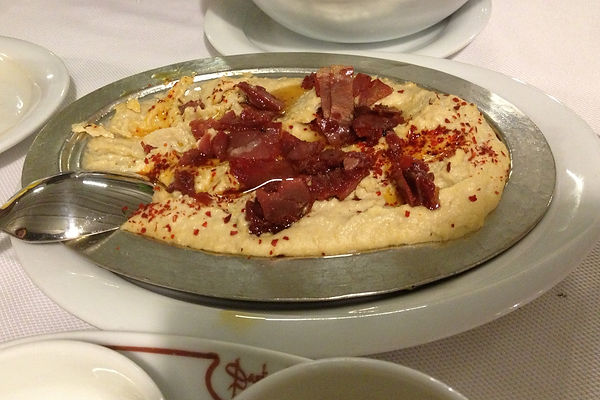
Pastırmalı Humus
-
‘Gözleme’ is made of yufka (hand-rolled dough leaves) cooked over a griddle. It is generally rolled with ground beef, vegetables, cheese, sucuk and pastırma. (flavorful, air-dried, pressed and cured beef).
-
‘Börek’ is baked filled pastries made of yufka It has many variants depending on your choice of filling. Most of them are prepared either with ground meat, sausage, sucuk, pastırma or cheese.
-
‘Mantı’: Dumplings filled with spicy lamb or ground meat topped with yogurt and a special hot tomato sauce. Dumplings can be boiled, steamed or sometimes baked in the oven after a short boiling process.
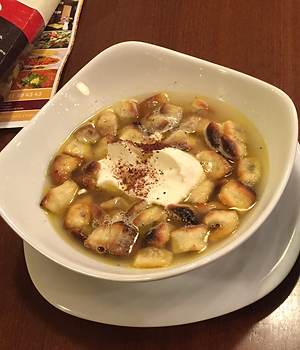
Mantı
-
‘Nohut-pilav’ is a very common winter dish prepared by putting stewed chickpeas on top of simple plain rice.

Nohut-Pilav
-
‘Bulgur pilavı’, is a kind of rice dish prepared with bulgur (durum wheat). Tomato paste, potatoes, meat and chickpea can be added.
-
‘Kuru fasulye’ is a stewed bean dish cooked preferably in a pressure cooker, mainly prepared with white beans, butter/olive oil, tomato paste and onions. This dish is acknowledged as the National food of Turkey.
-
‘Hünkar beğendi’ consists of a puree of grilled eggplant with kaşar (similar to Italian Parmigiano Reggiano) cheese. It can be topped with chopped pieces of lamb meat as you wish.
-
‘Karnıyarık’ is also an eggplant-based dish where the eggplant is cut by half and ripped from the center to be stuffed with ground meat (or diced chicken), chopped onions, garlic, tomatoes and hot capsicum.
-
‘Kadınbudu köfte’ is a type of meatball prepared with sautéed ground mutton, some amount of raw ground meat, boiled rice, chopped onions, parsley, oregano and salt, molded with whipped egg and finally fried with sunflower oil at a saucepan.
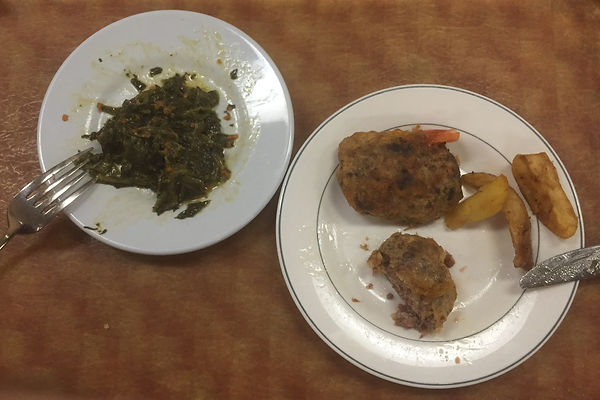
Kadınbudu Köfte
-
‘Döner kebap’ is made of seasoned meat cooked on a vertical rotisserie, generally prepared with either lamb or beef. It is the most famous and worldwide known kebab. It can also be made of chicken.
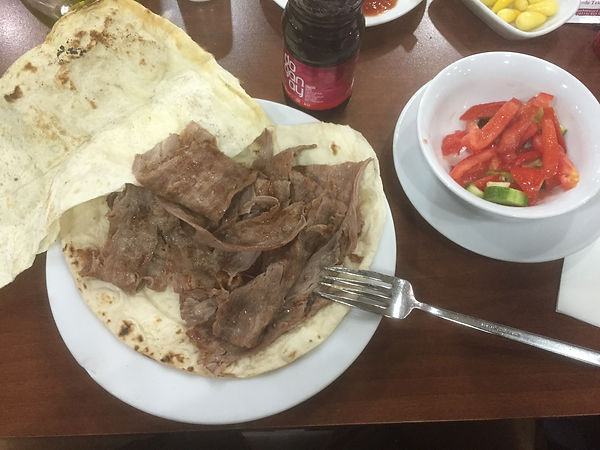
Döner Kebap
-
‘Fıstıklı kebap’ is a type of kebap made of ground lamb and pistachios seasoned with various spice.
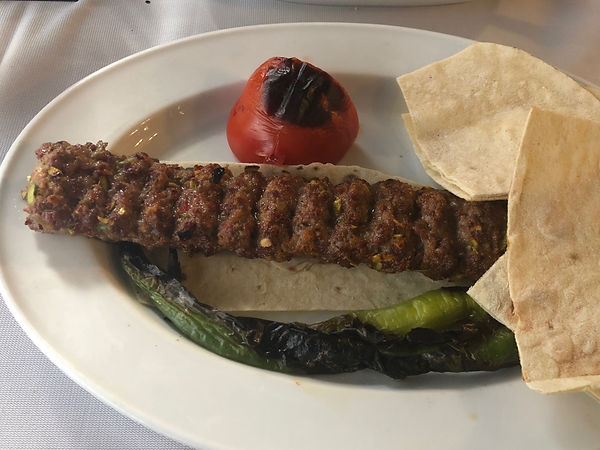
Fıstıklı Kebap
-
‘Sac tava’ is prepared in cast iron tinplate. You first fry lamb tail fat in highly heated plate, take the substance fat out, dump chopped onions and green peppers. When the mixture release its juice, add the diced lamb on top and start stirring. You may add tomatoes per your taste with favorable seasonings.
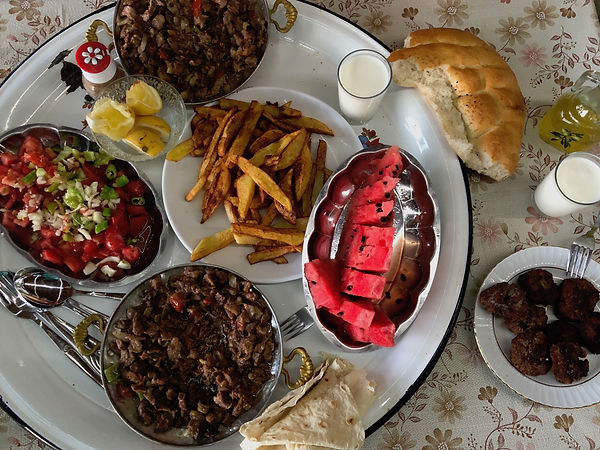
Sac Tava
-
‘Maraş dondurma’ is coming from an Anatolian city, famous with its special mastic ice creams. Maraş is the name of the city and vanilla ice cream is the most famous type. It is considered as one of the national symbols, only to be found in Turkey.
-
‘Aşure’ is also generated from Armenian culture. Armenian pronunciation is ‘Anoush Abur’, meaning sweet soup. It’s a very nutritious porridge type dessert, cold served and generally prepared in winter season. Traditionally, it is said that it hosts at least seven ingredients. Generally, wheat, rice, beans, chickpeas, sugar, dried fruits, various kinds of nuts, pomegranate kernels and rose water are among the preferred elements. Some sources claim that the name of this dessert is called ”Noah’s pudding“ according to a legend.
-
‘Güllaç’ is a dessert made with yufka, milk, pomegranate kernels, walnuts and rose water. It is the most typical dessert during Ramadan.
-
‘Lokum (Turkish delight)’: World famous confection (candy) based on gel, sugar and starch. There are infinite types mainly prepared mixing fruit flavors with different types of nuts.
-
‘Boza’ is a popular fermented wheat beverage usually consumed in cold weather. It has a thick consistency with a very low alcohol content, and a slightly acidic sweet flavor. It is generally served with cinnamon and leblebi (roasted chickpeas).
-
‘Salep’: Here comes a quick Salep recipe: 200ml skimmed milk, 1 Tablespoon Salep flour, half Tablespoon potato starch, sugar and cinnamon for strewing. Salep flour is made from the tubers of the orchid genus Orchis.
The Caucasian effect is clearly observed in the Black Sea cuisine. The dishes get similar to the Caucasian cuisine in the far eastern parts of the Black Sea region in the north seacoast of Turkey. The Black Sea climate has an impact on this regional cuisine. Its indigenous dishes are completely different from each other possessing their own uniqueness in taste and presentation. Here are some examples of the cuisine:
-
‘Mıhlama’ is common corn porridge in eastern Black Sea region. It is made of corn flour, butter and a rare regional cheese named çökelek. Kaymak (clotted cream) is added in some districts.
-
‘Yayla çorbası‘ is a yogurt soup cooked with a variety of herbs such as mint, spinach, parsley, flour, rice and sometimes chickpeas.
-
‘Çerkez tavuğu’ is a cold appetizer made of shredded boiled chicken served under or in a rich paste made with crushed walnuts, and stock thickened with stale bread.
-
‘Kara lahana sarması’: Kale or boerenkool leaves are boiled in water and let dry first. Then leaves are stuffed with rice or bulgur, rolled by hands giving a tubular shape. Then, it is cooked in a stewpot and finally served with yogurt as a topping. Usually served with mısır ekmeği.
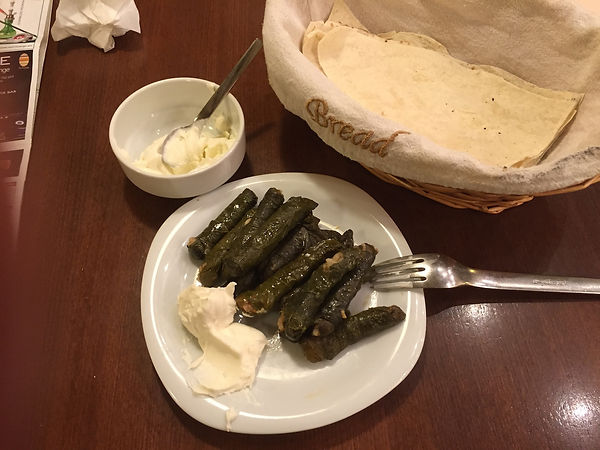
Kara lahana sarması
-
‘Mısır ekmeği’ is a local cornbread mostly prepared in eastern parts of the Black Sea region. It goes best with kara lahana sarması and ayran (diluted yogurt mixed with water and salt).
-
‘Hamsili pilav’ spiced rice covered with anchovies, cooked in the oven. An indigenous dish from the East Black Sea region.
-
‘Bolu Orman Kebabı‘ is cooked in oven in a wrapped baking paper. In the paper, lamb meat is placed on the bone cut in large pieces mixed with carrots, potatoes, peas and seasoned with oregano. An indigenous dish from the West Black Sea region.
-
‘Akçaabat köfte’: The adjective of this minced meat grilled köfte (meatball) comes from a specific town of Trabzon. It has a unique preparation method kept in secret by the indigenous locals.
-
‘Karadeniz pidesi’ is an ellipse-shaped pita bread, topped with several types of ingredients and baked in stone oven. Pastırma, sucuk, cheese with or without egg, ground beef, veal meet, spinach are the most popular ingredients to place on pide.
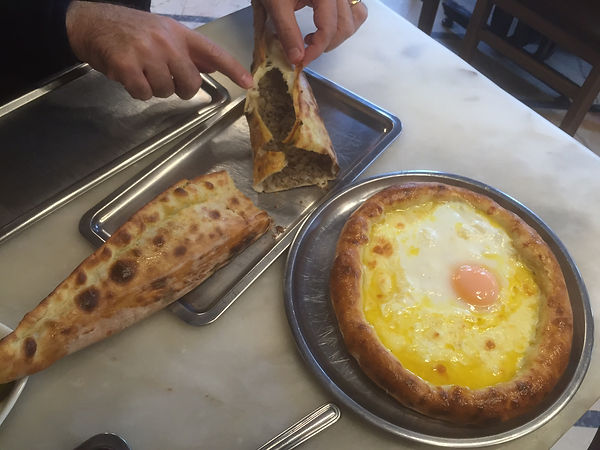
Karadeniz pidesi
-
‘Cağ kebabı’ is akin to Döner kebab. In the case of Cağ kebabı, rotation of the kebab is on a horizontal plane. Slices of lamb and large quantities of tail fat are left to marinate in a mixture of yogurt, black pepper and sliced onions for the length of a day. The mixture is then impaled on the spit (Cağ, a kind of skewer), and stacked thickly. The spit is then locked and transferred to the fire where there is a fairly complicated device that controls the cooking of the spit. Cooked meat is fairly sliced as thinner as it can be and served in either pita bread or simple sandwich bread accompanied with ayran.
-
‘Laz böreği’ is a sweet type of borek very similar to baklava. Apparently, it is prepared with baklava yufkası (dough layer for baklava), butter, custard and syrup.
Southeastern Anatolia cuisine is another part within the Turkish cuisine, with Levantine descent. It is extremely influenced by Kurdish, Syrian and Persian daily customs. Thus, this regional cuisine offers a diverse array of authentic food. Various kinds of spices play a significant role on delicate dishes. Below are the most traditional dishes of Southeastern Anatolia cuisine:
-
‘Ezogelin çorba’: The origin of the soup is attributed to Ezo, the bride from Gaziantep city. The ingredients of the hot soup are red lentils, rice, bulgur, olive oil, butter, onion, garlic, tomato paste, paprika, hot pepper, dried mint, black pepper and salt. It is generally served with lemon wedges.
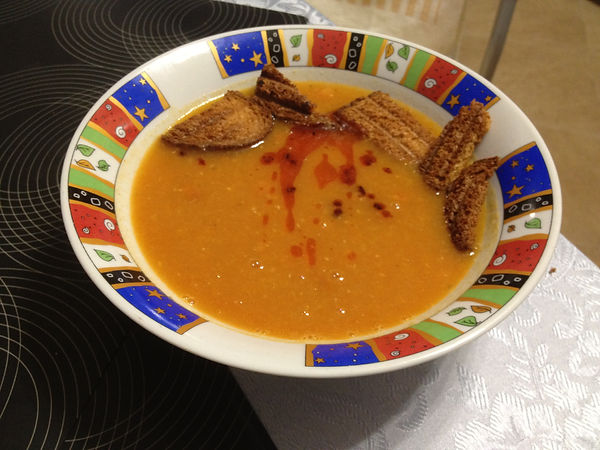
Ezogelin çorba
-
‘Işkembe çorbası’ is translated as tripe soup. The dish is generally made of cow's stomach and eaten usually with a vinegar-garlic sauce added on the table or with the addition of an egg yolk-lemon juice in the kitchen, after cooking and prior to service. It is said to be a hangover remedy according to folklore so it is generally consumed before sleep.
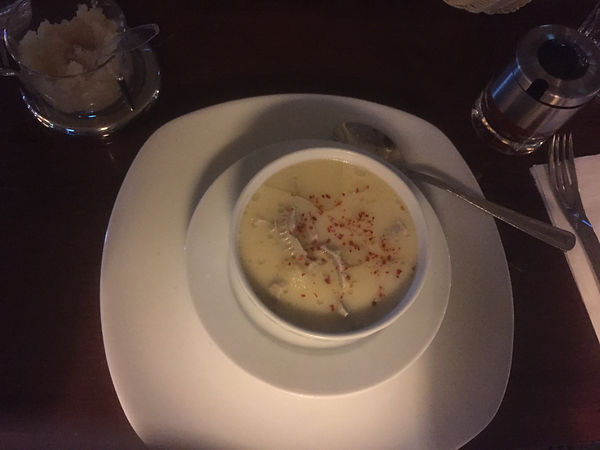
İşkembe çorbası
-
‘Çiğ köfte’, meaning raw meatball, is a raw meat dish consisting of raw ground beef, bulgur, chopped onions, pepper paste, tomato paste and a very dark almost blackish paprika called isot (found only in Şanlıurfa city). It is commonly consumed by rolling in a lettuce leaf accompanied with lemon wedges.
-
‘Kısır’ is a traditional cold appetizer consisting of finely ground bulgur, parsley and tomato paste. Especially in southeastern regions, sour pomegranate molasses, chopped onions, lemon and lots of spices can be listed as additional ingredients.
-
‘Gavurdağı salatası’ is a type of salad mainly based on chopped tomatoes. Other ingredients are minced walnut, chopped onion, hot capsicum, shredded garlic, parsley, fresh mint, salt, black pepper and red pepper flakes. Finally, sour pomegranate molasses, olive oil and lemon juice mixture are topped.

Gavurdağı salatası
-
‘Perde pilavı’ is a type of rice with partridge or chicken, onion and peanuts enveloped in a thin layer of dough prepared with egg, butter and milk, topped with almonds. It comes out in a cake shape after baking in the oven. This authentic dish, usually served for guest, is served in slices.
-
‘Lahmacun’, also known as Turkish pizza, is a round (sometimes elliptic), thin piece of dough topped with minced meat (most commonly beef or lamb) and minced vegetables and herbs including onions, tomatoes, parsley and isot. Garnishing with walnuts has become also trendy in the last decade.
-
‘Keşkek’ is a sort of ceremonial chicken and wheat or barley stew. Since 2011, Keşkek has become an Intangible Cultural Heritage of Turkey confirmed by UNESCO.
-
‘İçli köfte’ is a Levantine dish. The most common variety is a torpedo shaped fried croquette made of bulgur (cracked wheat) and stuffed with minced onions, finely ground lean beef, lamb or goat meat seasoned with special spices.
-
‘Alinazik’ is a smoked and spiced eggplant dish, which is firstly seasoned and marinated, then grilled and pureed, topped with cubes of sautéed lamb. It is a common home-style dish served with melted butter on top of it.
-
‘Tantuni’ is a spicy lavash (soft, thin flatbread ) wrap consisting of julienne beef or lamb stirred in a sac (sheet metal plate) with a hint of cotton oil. While it is a specialty of the city of Mersin, it is also quite easy to find at fast food restaurants in Istanbul.
-
‘Beyti’ is a type of a ground beef or lamb kebab grilled on a skewer and served wrapped in lavash topped with tomato sauce, accompanied by strained yogurt.
-
‘Urfa/Adana kebabı’ is a long hand-minced meat kebab mounted on a wide iron skewer and grilled on an open barbeque filled with burning charcoal. It can either be served in a plate or wrapped in a dürüm (large loaf of flatbread). The hot and spicy version is called Adana, while Urfa contains less spice. Moreover, Urfa is a bit thicker than Adana kebab.
-
‘Şalgam’, meaning turnip water, is a popular non-alcoholic beverage usually served with any kind of kebab, lahmacun or beside the most famous Turkish alcoholic drink Rakı. Prior drinking, hot paprika relish is added.
-
‘Turkish Baklava’, generally prepared in large pans, is made with layers of Phyllo dough separated with melted butter and vegetable oil and filled with chopped nuts, walnuts or pistachios in the lowest layer. After baking in a special oven, hot honey syrup is poured over cooked baklava and allowed to soak the syrup in. Except nutty baklavas, there are plenty of other types of baklava like chocolate baklava, plain baklava with kaymak and so on.
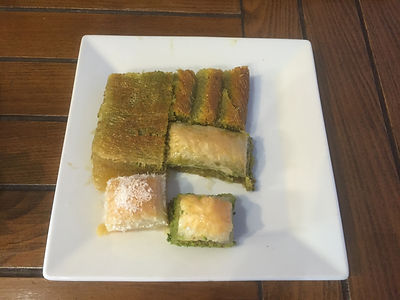
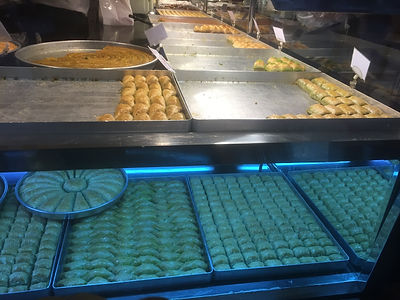
Turkish Baklava
-
‘Künefe’ is a Levantine cheese pastry soaked in sweet-sugar based syrup. It is cooked in small copper plates, and then served very hot in syrup with clotted cream and topped with pistachios or walnuts.
Aegean cuisine is more likely to be vegetarian-friendly. Except some meat dishes, the cuisine represents side dishes (mezzes) generally based on olive oil. Seafood is one the most common element of this light cuisine. As Aegean Sea surrounds the region, preparing delicate seafood mezzes is inevitable. Moreover, the proximity to the sea makes it possible to catch fresh fish at all seasons. On the other hand, thanks to the perfect climate, locally grown fresh vegetables and fruits play a big role in the preparation of local drinks and vegetable-based side dishes. Let me introduce you a few of the glorious recipes from one of my favorite cuisines:
-
‘Menemen’ is an often breakfast dish which includes eggs, onions (not necessarily), tomato, capsicum and spices such as oregano, black pepper, salt and red pepper flakes. It is cooked with olive oil or butter in a frying pan. Although cheese, pastırma or sucuk is not in the original recipe, they may be added depending on your taste.
-
‘Kaymak’, as afore mentioned, is a creamy dairy product very similar to clotted cream made from the milk of cows, sheep or goat (the most tasty type). It is mostly served at breakfast. It goes best as a spread on bread with honey or jam. Also, it is a very popular topping item eaten with some desserts like quince dessert, ekmek kadayıfı, Kemalpaşa tatlısı. Besides all, it is best with baklava.
-
‘Simit’ is circular bread, looking like a bagel, typically encrusted with sesame seeds. Gevrek (called in the city of Izmir), serves well as a good snack or can be consumed at breakfast with a cup of well-steeped Turkish tea. Simit, generally sold by street vendors, is an important symbol for lower and middle-class people of Turkey.
-
‘Cacık’ is a cold appetizer made of salted strained or diluted yogurt mixed with chopped cucumber, garlic, salt and olive oil. Usually seasoned with herbs such as dill, mint and parsley. It resembles tzatziki sauce of Greece.
-
‘Midye dolma’ is translated as stuffed mussels. It is one of the unique appetizers, which can only be found in Turkey. It is made of plump orange mussel, herbed rice, pine nuts and currants .The most delicious ones are prepared by street vendors in seacoast touristic cities Bodrum and Çeşme.
-
‘Pilaki’ is a type of cold appetizer generally made of bean derivatives. Beans are cooked in a sauce prepared with onion, garlic, carrot, potato, tomato, sugar and olive oil. It is always served cold, garnished with parsley and slices of lemon or lemon wedge.
-
‘Zeytinyağlı dolma’ is a cold appetizer prepared by wrapped and olive-oiled vine leaves tenderized with grape seed oil filled with a mixture consisting of rice, onions, currants, black pepper, all spice, cinnamon and pine nuts.
-
‘Zeytinyağlı enginar’ is a type of cold served appetizer. Artichokes are cooked in a sauce prepared with onion, garlic, carrot, potato, tomato, sugar and olive oil. It is usually garnished with parsley and lemon wedge.
-
‘Lakerda’ is a pickled bonito dish which was consumed as a mezze in the former Ottoman Empire, while sometimes large mackerel or small tuna were also used instead of bonito. The culinary tradition brought the recipe from the past to the present. It is claimed that the name comes from Byzantine Greek lakerta, mackerel.
-
‘Midye tava’ is a kind of hot appetizer. To explain it simply, it is fried mussels in sunflower oil usually served with tarator sauce.

Midye tava
-
‘Karides güveç’ is an indigenous hot appetizer of Turkish cuisine. It‘s a seafood appetizer made of shrimp sautéed with tomatoes, tomato sauce, garlic, capsicum, onion and minced mushrooms. It is commonly baked in a clay pot in an oven.
-
‘Edirne tava ciğeri’ is a hot fried lamb liver dish, served with deep-fried red peppers, sliced onion and sometimes scallion.
-
‘Kokoreç’ is a fast food dish, consisting mainly of lamb or goat intestines, wrapped in bread, seasoned with oregano, red pepper flakes and salt.
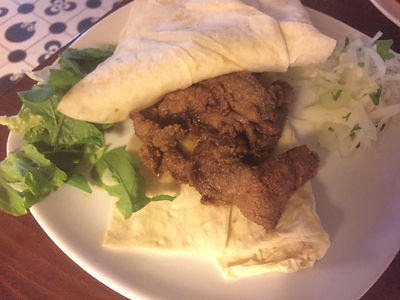
Edirne tava ciğeri
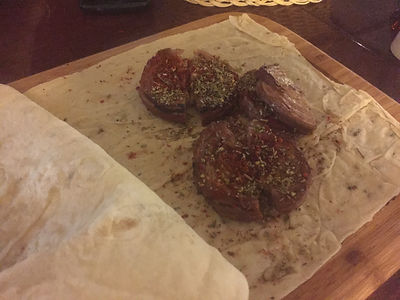
Kokoreç
-
‘Inegöl köfte’ is grilled meatballs specific to Inegol, Bursa. Meatballs consist of veal, lamb, salt, black pepper, sodium-bicarbonate breadcrumbs, and minced onions.
-
‘Iskender kebap’ is a version of döner kebab prepared with thinly cut grilled lamb basted with hot and spicy tomato sauce over pieces of special pita bread and generously slathered with melted sheep butter and served with yogurt near side. The name is derived from its inventor Iskender Efendi, who lived in the late 19th century in Bursa.
-
‘Yayık ayran’ is a unique type of fermented ayran, prepared with butter, having a strong sour taste. It is commonly drunk with burgers, toasts, kokoreç, pides, kebabs, meatballs and lahmacun.
-
‘Türk rakısı’ is a national distilled alcoholic beverage strongly aromatized with lots of anise. As it is made from different fruits, grapes, figs and plums are the prime ones. It is a cold drink served in cylindrical glasses with or without water as preferred. In slang language, it is called Lion‘s milk. It goes best with cold appetizers (mezzes) of Turkish cuisine.
-
‘Tavuk göğsü’ is translated as chicken breast. It is a cold milk pudding made with shredded chicken breast, milk, sugar and rice flour flavored with cinnamon powder. It is now considered among the signature dishes of Turkey.
-
‘Zerde’ is a sweet rice pudding with ingredients of raisins, cornstarch, rose water, curcuma and pistachios colored yellow with saffron. It is a popular festive dish served at weddings and birth celebrations.
-
‘Lokma’ are pastries made of deep fried dough soaked in sugar syrup and honey with cinnamon. It is introduced to the world from the city of Izmir (the farthermost west city in Turkey).
-
‘Fırın sütlaç’ is a rice pudding baked in a clay pot, often browned in a salamander broiler, then served as cold and garnished best with cinnamon and granulated hazelnut.
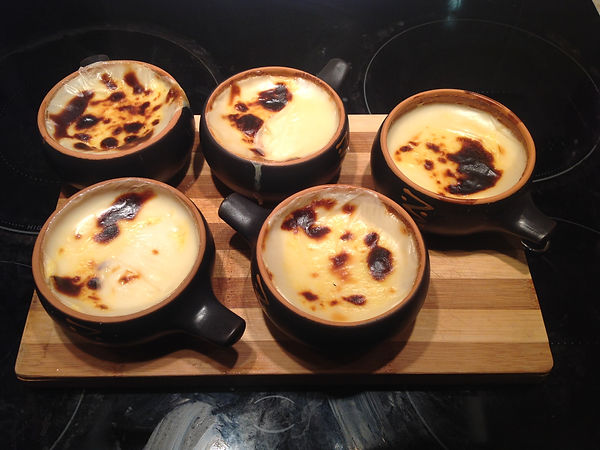
Fırın sütlaç
There is still a lot to say about one of the greatest cuisines of the world. Now, I want to emphasize the most significant components of the Turkish recipes. These are spices, fresh fish, Turkish cheese and Turkish coffee. In order of importance, from my point of view, of course, I will shortly try to explain their importance in the Turkish cuisine.
Spices are the inevitable elements for most of the dishes in the Turkish cuisine. They play a significant role as they add aroma and a delicate taste to the dish. The lack of spices may cause the dish to become tasteless. One of the key intersection points of the spice trade routes passes over Istanbul. Therefore, Istanbul has a great reputation for having top quality spices for ages since the ancient times. Hosting a big trade hub, the city has always provided almost all kinds spices to the rest of the country. This said, southeastern Anatolia region is also very rich in its spice resources since the ancient times, dating back to the grand Levant area.
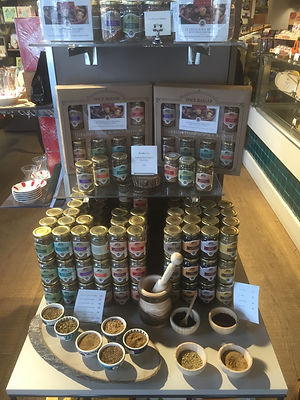
Assortment of Turkish Spice
Fresh fish has always been in demand by people who are used to living by the seaside. As Turkey is surrounded by two inner and two open seas, the country is always rich in fresh fish. Every sea offers its own types of fish depending on the salinity ratio. Thus, a fish caught in the Black Sea comes from a totally different family. This leads to a unique variety of fish breeds that is rarely found in other countries and cuisines. I, personally prefer fish from either the Aegean or the Mediterranean sea. Fish from those seas come out fattier and well-fed compared to the fish from the inner seas of Turkey. High salinity ratio in those open seas also plays a positive role on the delicacy of the fish. My most favorite types of fish are grilled Lagos (White Grouper), fried Kalkan (Turbot) and grilled Deniz Levreği (Mediterranean sea bass). Apart from being grilled or fried, there are other fish-based cold or hot appetizers served at seafood restaurants in Turkey. To reiterate, fish remains as popular as meat dishes and has always taken part in Turkish cuisine as its nutritious element.
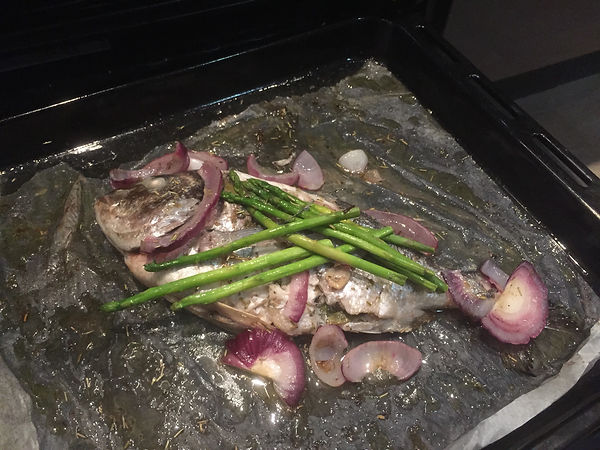
Bluefish/Çinekop in oven
It's believed that the cheese has originated from Mesopotamia, a region considered as the "cradle of civilization" and covers the strip of land between the Tigris and Euphrates rivers in southeastern Turkey and Iraq. Since then, cheese has occupied an important part of the Turkish culinary tradition. It is frequently used in desserts, served at breakfast tables, topped on salads, filled in pastries, added in meatballs and kebabs, even an item in soups, and sometimes served as mezze accompanying main dishes. Depending on various preparing methods, almost all regions have their own traditional cheese. Amongst them, beyaz peynir, which is my favorite (salty brine cheese similar to Feta cheese), Trakya kaşarı or Eski kaşar ( medium-hard pale yellow very close to Italian cheeses-Permigiano Reggiano and Romano cheese), which is from a specific region called Trachia, Tulum peyniri (made by heating high-fat goat's milk to a temperature of 30 °C and subsequently souring it through addition a starter culture), Dil peyniri (stringy fresh milk cheese resembling Italian Mozzarella cheese), Van otlu peyniri ( known as ‘Van herbed cheese‘ in the world literature, a type of cheese made out of sheep‘s milk having the aroma of garlic and thyme due to added herbs), and finally Çökelek peyniri (a unique cheese to the Antiochia region in southern Turkey consisting of milk, yogurt, red pepper paste, thyme and salt) are the unique ones which never be met by chance out of Turkish border.
The traditional Turkish coffee, a worldwide wellknown coffee sort, surely deserves to be spoken in such topic. Coffee seed was first discovered around Ethiopia. Then, it travelled to Arabian peninsula. Subsequently, it visited Turkey and the first known coffee shop in the world history was established in Constantinople (former name of today‘s Istanbul). As a matter of fact, one of the first coffee preparation tecniques have been invented and implemented in Turkey. Thus, Turkish coffee brewed in Turkish coffee pot (cezve) has become widespread in the culture as a routine. So, afterwards, the coffee custom was also settled in the Ottoman Empire era. Since then, it is like vital after meals.
Before concluding my article, I would like to announce my top 10 dishes. ‘Grilled Lahoz fish’(white grouper) tops my list as I adore seafood. Although I’m not so sure about the runner-up, I will vote for the most authentic Armenian mezze ‘Topik’ as my second best choice. My third favorite is going to be ‘Midye Dolma’ just because I can‘t resist mussels and reminds me of indelible memories from juvenile. ‘Döner kebap’ is going to be next as my fourth best. ‘Mantı’ will take the fifth place in my list. ‘Kadınbudu köfte’ will be listed as my sixth best option. ‘Pastırmalı humus’ will occupy the seventh place. Eighth place will be honored by ‘Kara lahana sarması’ from Black Sea region. ‘Fırın sütlaç’ comes just before the last one. Eventually, the last and the hardest one to select from the grand cuisine is ‘Işkembe çorbası’ as it takes the tenth place.
